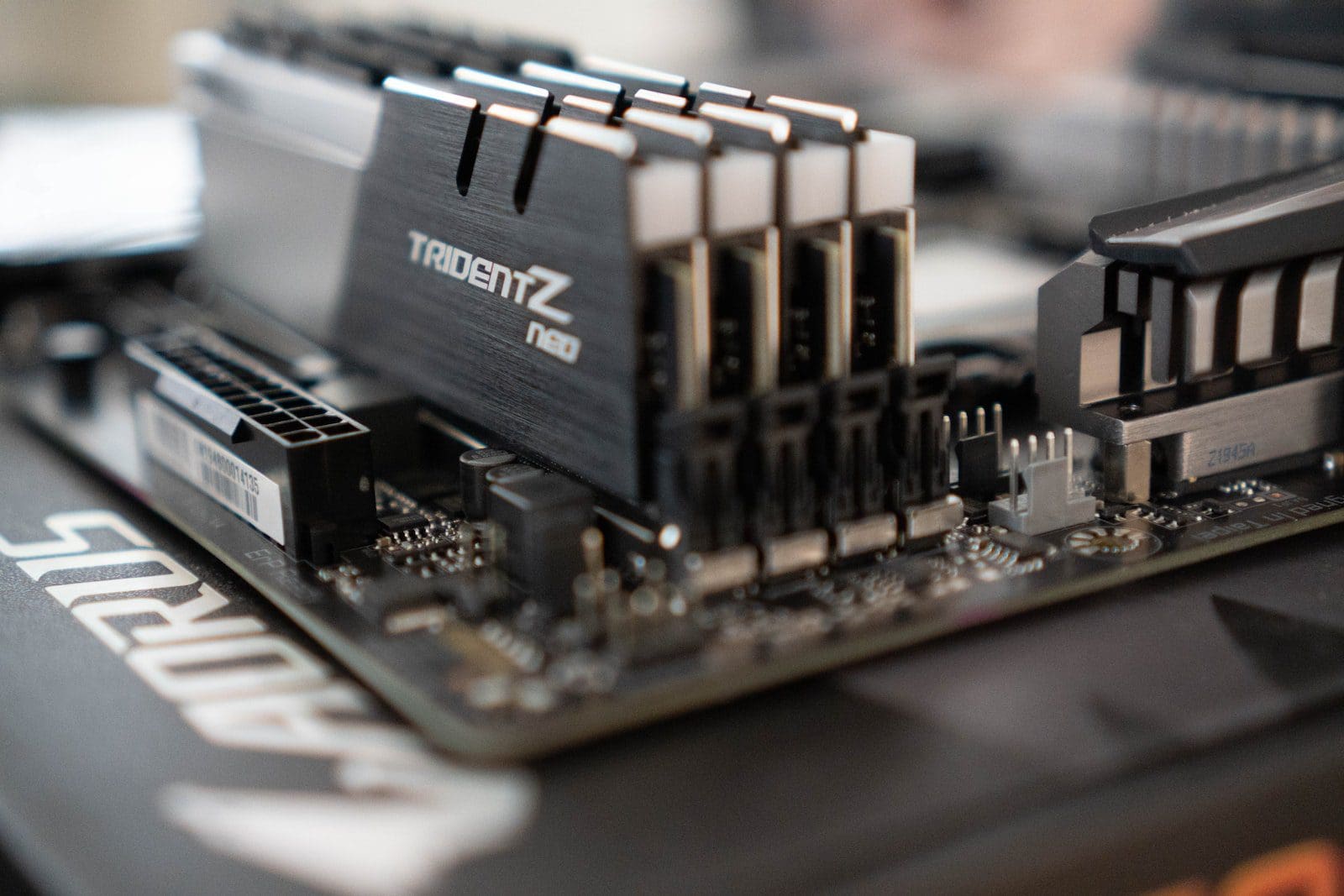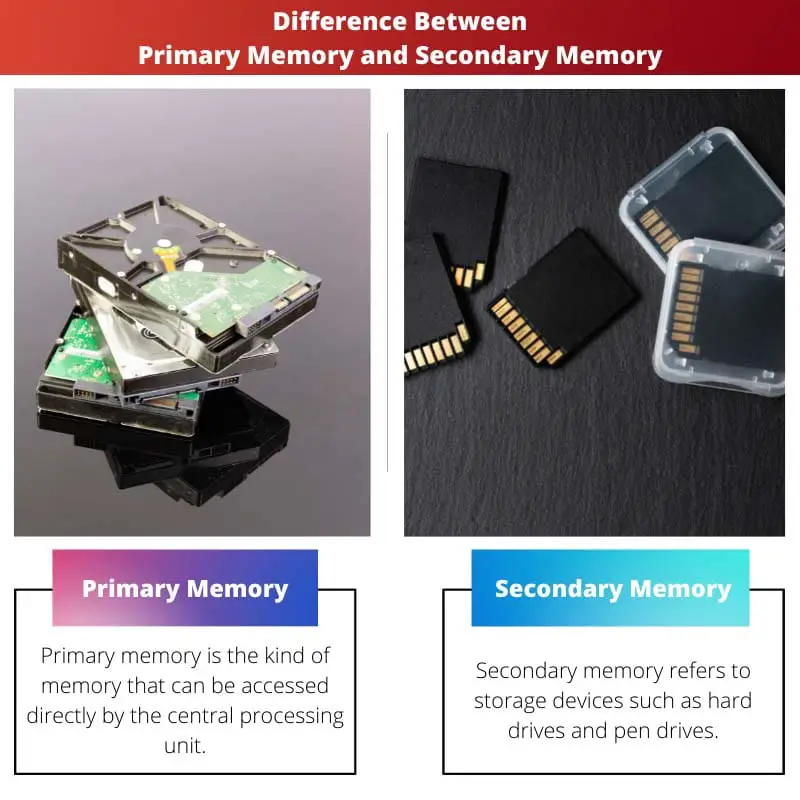In computers, memory is considered as one of the most essential parts. The device stores information in the computer for immediate use or later.
It can also be considered as the brain of the computer. Computer memory is basically of two types: primary and secondary.
Memory stores data inside itself for retrieval. Both primary and secondary memory have very different processes by which they save data.
The central processing unit then processes the data.
Key Takeaways
- Primary memory, or RAM, is volatile, temporary storage used by the computer to store current data; secondary memory, or storage, is non-volatile, permanent storage used for long-term data storage and retrieval.
- Primary memory is faster and more expensive than secondary memory; secondary memory is slower but has a larger capacity and is less expensive.
- Primary memory is limited by the amount of RAM installed on the computer; secondary memory can be expanded with external hard drives or other storage devices.
Primary Memory vs. Secondary Memory
Primary memory, also known as main memory or random access memory (RAM), is a type of volatile memory directly accessible to the CPU. Secondary memory is a type of non-volatile memory used to store data for long-term use and is slower to access but is also much larger in capacity.

Primary and secondary memory are parts of the main memory unit in a computer that is used for storing and processing data.
Comparison Table
| Parameters of Comparison | Primary Memory | Secondary Memory |
|---|---|---|
| Storage Validity | It is the main memory, and the data is stored temporarily. | It is the external memory, and the data is stored permanently. |
| Access | The CPU can directly access data. | The CPU cannot directly access the data. |
| Volatility | This type of memory is volatile, and the data is lost in case of a power failure. | This type of memory is non-volatile, and the data is stored even in case of power failure. |
| Storage Device | The data is stored inside very expensive semiconductor chips. | The data is stored in external hardware devices like hard drives, floppy disks, etc. |
| Division | It can be divided into cache and random access memory (RAM). | They have no such divisions and are permanent storage devices like CDs, DVDs, etc. |
| Speed | It is faster than the secondary memory. | It is relatively slower. |
| Data Stored | It saves the data that is currently being used by the computer. | It can save various kinds of data in several formats and huge sizes. |
What is Primary Memory?
Primary memory is the kind of memory that can be accessed directly by the central processing unit. It includes several types of memory like RAM (Random Access Memory), ROM (Read Only Memory), and cache memory.
Primary memory is erased when the computer is shut off, and the data is not saved. The data transferred between the CPU and RAM is a hundred times faster than the speed of data transfer between the CPU and the hard drive.
Primary memory can also be called primary storage. Primary memory is expensive, and technology is constantly being used to develop and optimize it.
While RAM loses its memory, ROM can store program data permanently.

What is Secondary Memory?
Secondary memory refers to storage devices such as hard drives and pen drives. The storage device can either be removable or non-removable.
The data stored inside secondary memory devices is stored permanently. The storage capacity of secondary memory is also much larger than primary memory.
Operating systems, applications, and other files can be stored inside secondary memory devices. It can also be called external memory, as it is not always a part of the device.
Secondary memory devices are also slower and much cheaper than primary memory devices. Data stored inside the secondary storage device is organized in an accessible way and can show at what time, where, and what kind of file was stored.

Main Differences Between Primary Memory and Secondary Memory
- Primary memory is the computer’s main memory, saving data temporarily. Secondary memory is the external memory that can be saved permanently.
- The CPU can directly access data saved in primary memory, which is not the case in secondary memory.
- Primary memory is lost in case of a power cut, while secondary memory remains saved. Hence primary memory is volatile and secondary memory is non-volatile.
- Primary memory is stored in semiconductor chips, while secondary memory is stored in external hardware devices.
- Primary memory is categorized into cache and random access memory, whereas secondary memory has no such categories.
- Primary memory is faster than secondary memory.
- Primary memory uses the computer’s current data, while secondary memory can save data in various formats that can be accessed at any time.

- https://psycnet.apa.org/record/2006-23341-004
- https://psycnet.apa.org/record/1974-04901-001
- https://books.google.com/books?hl=en&lr=&id=yR8tq_YznMwC&oi=fnd&pg=PA378&dq=secondary+memory+of+computer&ots=1YbUH3R26l&sig=ZHcxYl28ZKaG0yZ2xhX7McSWdVs
Last Updated : 11 June, 2023

Sandeep Bhandari holds a Bachelor of Engineering in Computers from Thapar University (2006). He has 20 years of experience in the technology field. He has a keen interest in various technical fields, including database systems, computer networks, and programming. You can read more about him on his bio page.

The detailed explanation of primary and secondary memory is commendable. A great resource for understanding computer memory.
Absolutely, the comparison of the access and availability of primary and secondary memory was enlightening.
I wholeheartedly agree. The comparison of speed and data storage between the two types of memory was extremely informative.
The content not only provided a detailed comparison but also did a great job in explaining primary and secondary memories in depth.
Absolutely, the clarity it offers on the various parameters of comparison is highly commendable.
The article does justice to the extensive comparison between primary and secondary memory. Well-explained.
Couldn’t have said it better myself. The clear explanation of the storage validity and speed of memory access was very engaging.
The article achieves a great balance of providing detailed insights into the primary and secondary memory without complicating things.
Absolutely, the explanation of the division and speed of primary and secondary memory was very well-structured.
The article provided a clear and informative explanation of the differences between primary and secondary memory. Good job!
Absolutely, the comparison table makes it easy to understand the different aspects of primary and secondary memory.
The article was quite enlightening, and the explanation about the nature of data stored in each type of memory was very helpful.
Agreed. The information about the speed of data transfer and the usage of RAM and ROM was fascinating.
This information really helped me grasp the complexities of computer memory. Well written and very insightful.
Absolutely. The comparison of access, volatility, and data storage between the two types of memory was very helpful in understanding.
I felt the same way after reading it. A top-notch display of knowledge.
This content is essential for anyone trying to understand the importance of memory in a computer. Great read
The article really sheds light on the distinction between primary and secondary memory. It’s impressive.
I agree, and the detailed explanation about RAM and ROM adds significant value to the article.
The article is well-structured and leaves no room for confusion about the primary and secondary memory.
I couldn’t agree more. The clear division of storage devices and speed of memory access were explained wonderfully.
I liked how the article explained the difference in data stored and speed between the primary and secondary memory.
The in-depth comparison table really made it easy to distinguish between primary and secondary memory. Superb content!
Absolutely, the speed and division of primary and secondary memory were explained very effectively.
I agree. The details about the storage validity and storage devices were extremely beneficial.